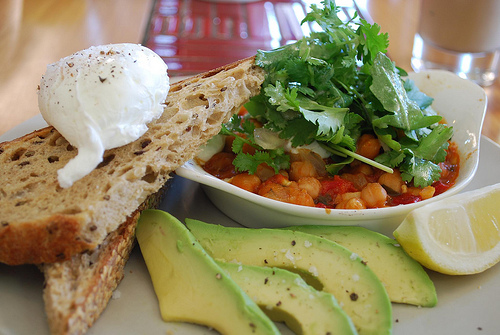In honor of the 2013 Senior Games, hosted in Cleveland this year, we’re making a commitment to better senior fitness and a happier, healthier life.
Fitness doesn’t end with exercise—eating well is a necessary part of living well.
A well-balanced diet provides the nutrients you need to keep your mind and body strong, and eating wholesome meals boost your energy and mood while helping to reduce your risk of common diseases and age-related conditions.
Our four tips for healthy eating help you get a jump-start on senior fitness.

1. Eat More Fruits and Vegetables
It’s an unfortunate truth that many older adults don’t eat enough fruits and vegetables—especially when the recommended daily serving only adds up to about 2.5 to 7.5 cups, depending on age, gender, and level of activity.
Good quality produce may be hard to find or seem like an unnecessary expense, especially during the long winter months we have here in Ohio, but pre-packaged and even canned produce is a better alternative to no fruits and vegetables at all, and frozen can be just as good as fresh, says Diane Stadler, PhD, RD, a research assistant professor of medicine at Oregon Health & Science University.
Fruits and vegetables have the nutrients and fiber that older adults need to face their heighten risk of heart disease, stroke, and other age-related conditions. And with their low levels of cholesterol, fruits and vegetables offer a healthier way to satisfy hunger than a bag of chips or handful of fries.
Tip: Look for the most colorful produce when you’re perusing the stands at the local Farmer’s Market or browsing at your supermarket. Fruits and vegetables with brighter, richer tones (such as dark leafy greens like spinach or kale and dark purple fruits like blueberries and blackberries) tend to have more vitamins and antioxidants.
2. Opt for Whole Grains
Forget the Wonderbread and trade in your bleached flour. Going whole grain helps keep senior living more active and energetic. Unprocessed whole grains—such as wheat, rice, oats, cornmeal, barley, or other cereal grains— are one of the best foods to reach for when you need a boost of energy.
Whole grain foods are a natural source of vitamins, minerals, fiber, carbohydrates, and antioxidants that fight disease, regulate weight, and keep your body functioning smoothly and efficiently. All of these add up to a healthier senior living experience.
Tip: Make sure you’re choosing foods that have a whole grain listed first on the ingredients list. Some grain-based foods are processed and enriched, losing the nutrient-rich bran and germ that make grains so healthy.
3. Pick Protein
Protein helps you build the strong bones and muscles that you need to keep living well, and the body doesn’t store excess protein, so you need to eat protein every day.
Adults over 50 should be getting about half a gram of protein for every pound of healthy body weight they carry. If you have trouble with portions, Dr. Stadler recommends envisioning a single serving as a deck of cards. Any more than that, put it in a box to-go or stick it back in the refrigerator.
Tip: Vary where you get your protein. Lean meats like turkey or skinless chicken have less fat and fewer calories than red meat. Fish, especially oily fish like tuna or salmon, are an excellent source of heart-healthy omega-3 fatty acids. Beans are a great alternative source of protein and are high in fiber (a single ½ cup serving provides about a third of your daily requirement) as well as other vitamins and minerals.
4. Indulge in Dairy
Our bodies need a constant supply of calcium to build strong bones that protect our internal organs, anchor our muscles, and help keep us active and upright.
Bone health becomes increasingly important as we age. Stronger bones translates into greater mobility and a more active senior lifestyle, and dairy products are the single greatest source of calcium (and Vitamin D) that our bodies need to maintain strong and healthy bones.
Tip: Choose low fat or fat free cheeses, yogurts, and other dairy products to strengthen your bones and get an extra dose of protein, magnesium, vitamin A, and potassium.
Image Credit: avlxyz











